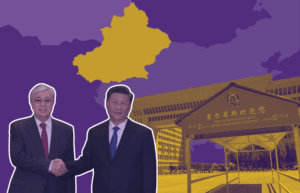In a book focusing on Central Asia’s relationship to Russia, researcher Michaël Levystone provides a careful insight into ties whose nature keep on changing. As they perform a balancing act between historical closeness and desire for independence, Central Asian countries strive to tip the scales in their favor in regards to their relationship to the “Russian older brother”.
This article was originally published on Novastan’s French website on 22nd September 2021.
A specialist in political, economic and cultural relations between Russia and Central Asia, Michaël Levystone has published in May 2021 “Russia and Central Asia at a crossroads”, a book which tackles the stakes concerning Central Asia vis-à-vis neighboring world powers Russia and China.
Michaël Levystone is working as a researcher at the Russian / CIS center within the French institute for International relations (Institut français des relations internationales). In the past, he worked at the French embassy in Kazakhstan and at the French Russian observatory of Moscow. His latest book provides analysis of an area which remains largely uncharted territory. His desire to develop knowledge of this region came from the years he spent studying at the French Institute for International and Strategic Affairs (Institut des relations internationales et stratégiques), when he wrote a dissertation on bilateral relations between Russia and Kazakhstan.
Military, political and cultural Russian influence on shaky ground
Michaël Levystone’s book offers a better understanding of economic, political and cultural relations which link Russia and the five Central Asian countries. Not only does it highlight the way these countries stand in relation to Russia, it also deals with the strategic role they play regarding China.
Answering Novastan’s questions, Michaël Levystone states that his book, although focusing on Russia’s both economic and security-related role in Central Asia, “could not exclude China from the realm of analysis, given its all-pervasive influence. A lot is at stake when it comes to Beijing.”
Read more on Novastan: More Russian passports, fewer labour migrants: Central Asian migration to Russia in 2020
The takeaway here is the fact that Russia has been relentlessly trying to maintain control and influence over those countries ever since they gained independence in 1991. It has notably been aiming to remain their major partner in energy and military issues. Further into the book, Michaël Levystone however emphasizes Central Asians’ late attempts not to be overpowered by their age-old Russian inquisitor.
Read more on Novastan: Russia tries new diplomatic approach with “Central Asia + Russia” format
However intense this desire can be in a given country, it is bound to be faced with Russian diplomacy’s unwillingness to relinquish such power. As a matter of fact, all of these actors participated in a video conference which took place on 15th October 2020 about a joint declaration “on the strategic directions taken by cooperation”.
Therefore, Central Asian countries try to further their independence from Soviet patterns, especially on the cultural level, as they uphold use of local languages over use of Russian, or as they gradually close down schools that were opened under Soviet rule.
Long-lasting fidelity put to the test
Central Asian countries are also challenging their historical ally by turning towards the Asian market, in particular towards Beijing and what it has to offer. This could lead to rising tensions between China and Russia. However, the book makes it clear that both countries have come to a “tacit agreement”, albeit still fragile.
Although Moscow seems less and less reluctant to let China achieve economic leadership in Central Asia, notably through the advent of the Belt and Road Initiative, Russia keeps on wielding “hard power” when it comes to weaponry and military matters. Its military bases in Kyrgyzstan and Tajikistan, as well as its arms supplies at a preferential rate through the Collective Security Treaty Organization (CSTO) are a testament to this.
China as an actor that can no longer be dismissed
This distinction appears not to be so clear-cut as it used to be. “Nowadays, Chinese influence is gradually but undeniably taking over. Chinese military presence is rising, as shown by their unofficial military base in Tajikistan, but also by strong synergies regarding security”, the author writes. Simultaneously, Beijing is each Central Asian country’s number one economic partner.
Read more on Novastan: Kazakhstan: Huawei to launch 5G network in 2021
China’s growing influence over Central Asia is not a myth. It partakes of Russia’s decline, which is military as well as industrial.
What makes this book fascinating lies in the chapters which explain the nature of different organizations in the region: the CSTO, the SCO (Shanghai Cooperation Organization), the EAEU (Eurasian Economic Union). Michaël Levystone therein points out that Russian supremacy was fueled by the creation of these institutions which all aim at maintaining control over independent yet formerly Soviet countries.
Read more on Novastan: Russia commits to railroad corridor China-Kyrgyzstan-Uzbekistan
Whether such domination be economic or cultural, Moscow’s attempts to keep a tight grip on those five countries – through culture, energy, the economy or military affairs – are clearly put into light in these passages.
Europe and America are nowhere to be seen
Although this may come as a surprise to the reader, the United States and most European countries lack interest towards Central Asia, in spite of this region’s growing challenges. While some effort has been put into developing presence there in the past few years, it remains quite limited.
Read more on Novastan: Uzbek products obtain privileged access to the European Union
Being at a crossroads between two continents which each have strong ambitions makes it a new economic hub. It also makes it vulnerable to threats posed by some neighboring countries’ extremist, if not terrorist aspirations. There is more to Central Asia’s role in diplomatic relations than meets the eye.
Read more on Novastan: Hardening Positions on Afghanistan following Summit in Dushanbe
To put it simply, Michaël Levystone’s book delves into the ties between Russia and Central Asia while pointing out growing indifference towards the former on the latter’s part, for the Russian neighbor regularly and considerably infringes on domestic affairs and capacity for self-determination. Today, this region is of great importance as it is at a crossroads between Europe and Asia.
While it wishes to get rid of the enduring Soviet yoke, Central Asia is no less coveted by China, which brings about new opportunities for those countries, although some fear that they might mean trading subjugation to one world power for subjugation to another.
Michaël Levystone’s book Russie et Asie Centrale à la croisée des chemins (not translated into English yet) was published by L’Harmattan (Paris 2021, 176 pages, €18.50(£15.82)).
Written by Emma Parisien
Translated from French by Andreï Fedorovsky
Edited by Emma Bekrine
For more news and analysis from Central Asia, follow us on Twitter, Facebook, Telegram, Linkedin or Instagram.
 Central Asia and Russia: an ever-changing relationship
Central Asia and Russia: an ever-changing relationship 



